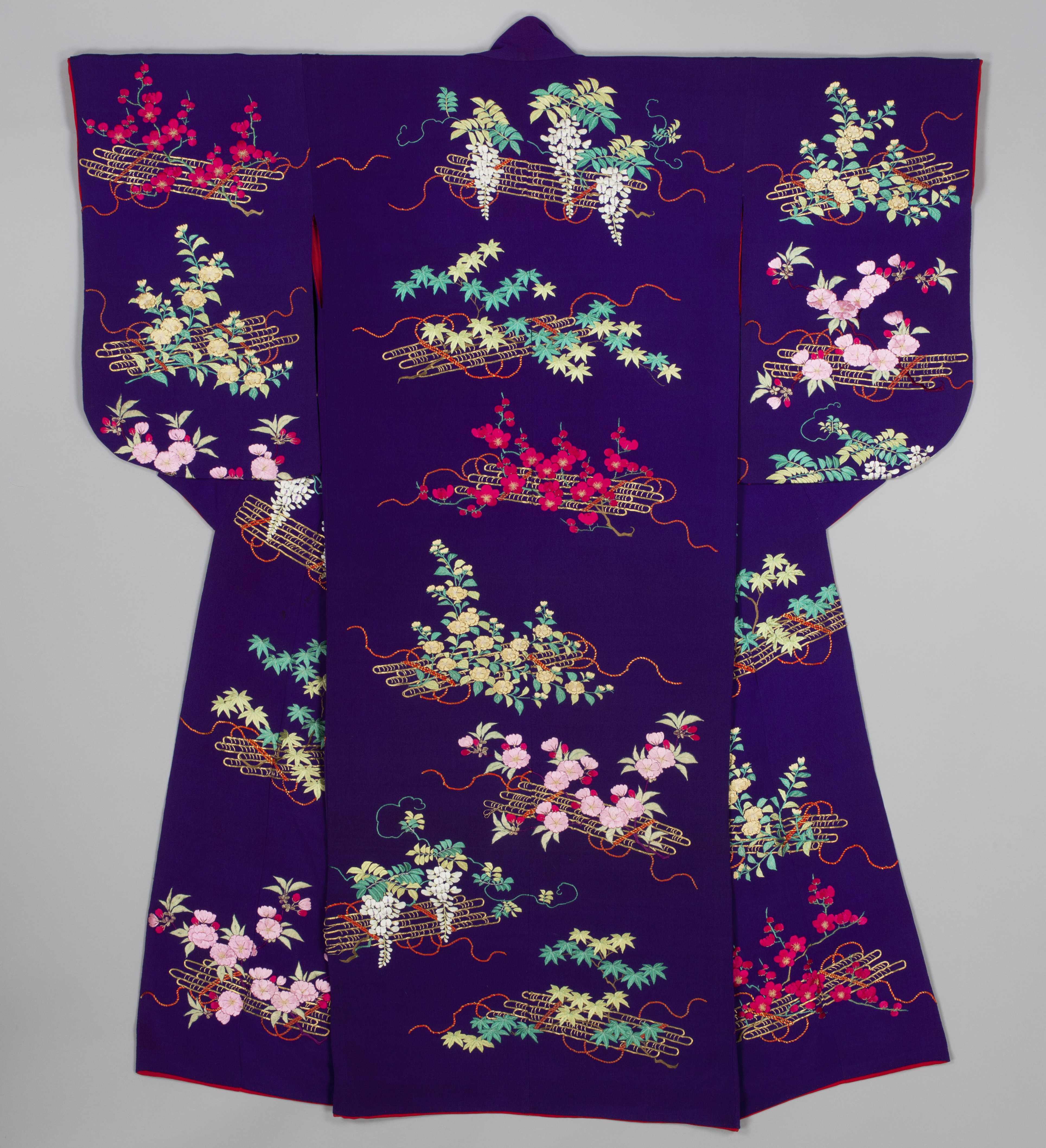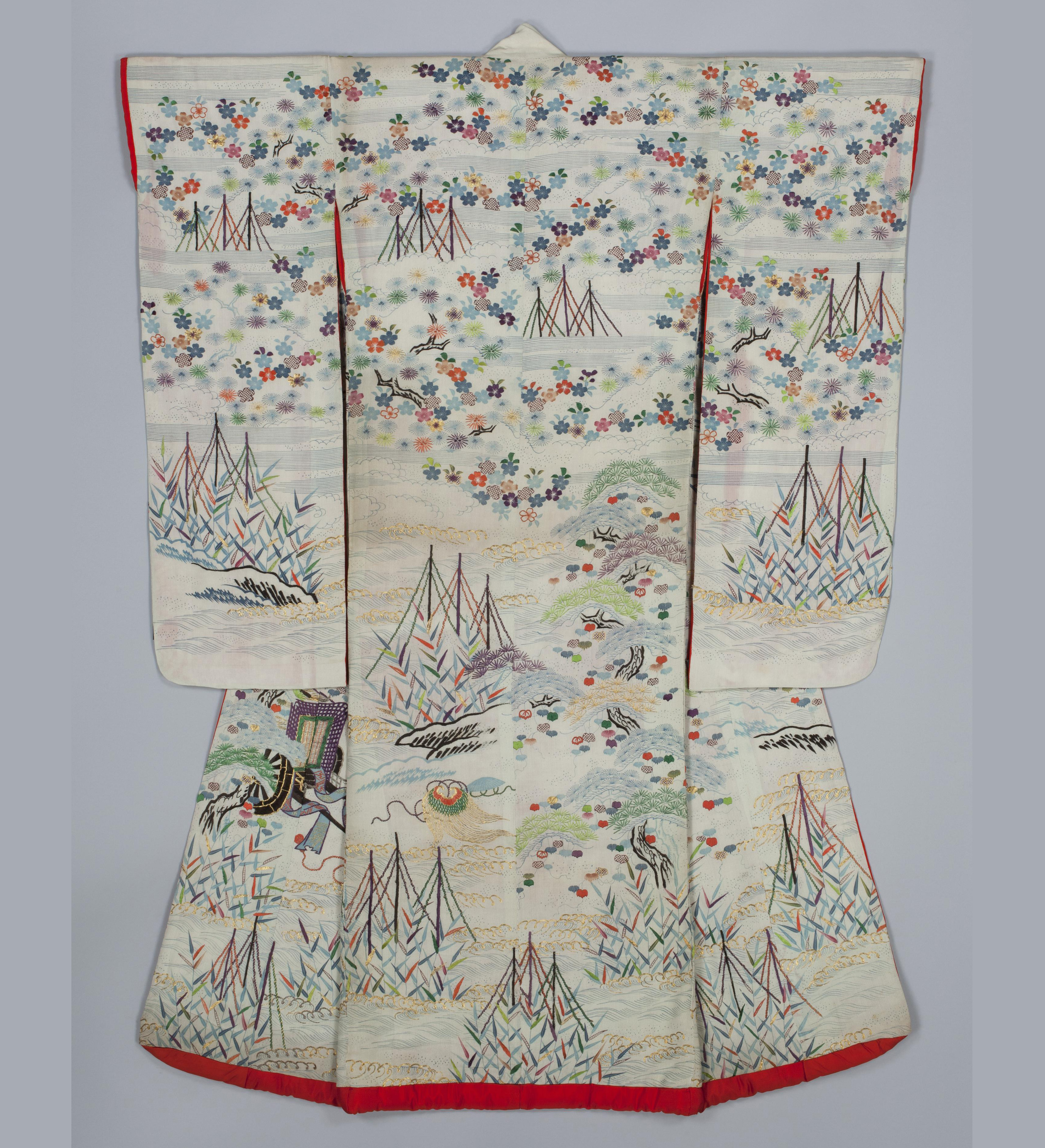Formality
Kimono range in variation from extremely formal to very casual. The formality of a woman's kimono is determined mostly by pattern placement, decoration style, fabric choice and color. The formality of men's kimono is determined more by fabric choice and coordination elements (hakama, haori, etc.) than decoration, as men's kimono tend to be one color with motifs only visible when looked at closely.
In both cases, formality is also determined by the number and type of kamon (crests). Five crests (itsutsu mon) are the most formal, three crests (mitsu mon) are mid-formality, and one crest (hitotsu mon) is the least formal, used for occasions such as tea ceremony.
The type of crest adds formality as well. A "full sun" (hinata) crest, where the design is outlined and filled in with white, is the most formal type. A "mid-shadow" (nakakage) crest is mid-formality, with only the outline of the crest visible in white. A "shadow" (kage) crest is the least formal, with the outline of the crest relatively faint. Shadow crests may be embroidered onto the kimono, and full-embroidery crests, called nui mon, are also seen.
Formality can also be determined by the type and colour of accessories, such as weave of obijime and the style of obiage.
Yukata
Yukata are casual cotton summer kimono. Yukata were originally very simple indigo and white cotton kimono, little more than a bathrobe worn either within the house, or for a short walk locally; yukata were also worn by guests at inns, with the design of the yukata displaying the inn a person was staying at. From roughly the mid-1980s onwards, they began to be produced in a wider variety of colors and designs, responding to demand for a more casual kimono that could be worn to a summer festival.
In the present day, most yukata are brightly colored (for women) featuring large motifs from a variety of different seasons. They are worn with hanhaba obi (half-width obi) or heko obi (a soft, sash-like obi), and are often accessorized with colorful hair accessories. Yukata are always unlined, and it is possible to wear a casual nagoya obi with a high-end, more subdued yukata.
Furisode
Furisode kimono are the most formal kimono for a young, often unmarried, woman. They are decorated with colorful patterns across the entirety of the garment, and usually worn to seijin shiki (Coming of Age Day) or weddings, either by the bride herself or an unmarried younger female relative.
The sleeves of the furisode average at between 100–110 cm in length. Chu-furisode (mid-size furisode) have shorter sleeves at roughly 80 cm in length; most chu-furisode are vintage kimono, as in the modern day furisode are not worn often enough to warrant buying a more casual form of the dress, though brand-new chu-furisode do exist.
Homongi
Hōmongi are distinguished in their motif placement–the motifs flow across the back right shoulder and back right sleeve, the front left shoulder and front left sleeve, and across the hem, higher at the left than the right. They are always made of silk and are considered more formal than the tsukesage.
Hōmongi are first roughly sewn up, the design sketched onto the fabric, before it is taken apart to be dyed again. The hōmongi's close relative, the tsukesage, has its patterns dyed on the bolt before sewing up. This method of production can usually distinguish the two, as the motifs on a hōmongi are likely to cross fluidly over seams in a way a tsukesage generally will not. However, the two can prove near indistinguishable at times.
Hōmongi may be worn by both married and unmarried women; often friends of the bride will wear hōmongi at weddings (except relatives) and receptions. They may also be worn to formal parties.
Men’s Kimono
In contrast to women's kimono, men's kimono outfits are far simpler, typically consisting of five pieces, excluding footwear.
Men's kimono sleeves are attached to the body of the kimono with no more than a few inches unattached at the bottom, unlike the women's style of very deep sleeves mostly unattached from the body of the kimono. Men's sleeves are less deep than women's kimono sleeves to accommodate the obi around the waist beneath them, whereas on a woman's kimono, the long, unattached bottom of the sleeve can hang over the obi without getting in the way.
In the modern era, the principal distinctions between men's kimono are in the fabric. The typical men's kimono is a subdued, dark color; black, dark blues, greens, and browns are common. Fabrics are usually matte. Some have a subtle pattern, and textured fabrics are common in more casual kimono. More casual kimono may be made in slightly brighter colors, such as lighter purples, greens and blues. Sumo wrestlers have occasionally been known to wear quite bright colors such as fuchsia.
-
 Yukata
Yukata -
 Furisode
Furisode -
 Homongi
Homongi -
 Men's Kimono
Men's Kimono